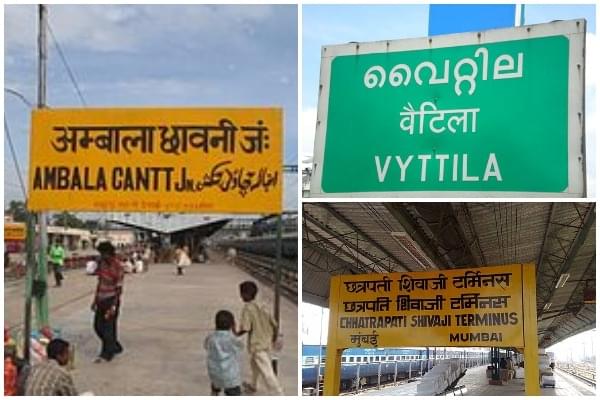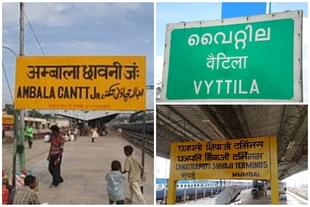Ideas
Saving Hindi From The Hindi-Wallahs: How To Separate Sense From Nonsense
R Jagannathan
Jun 24, 2017, 10:35 AM | Updated 10:35 AM IST
Save & read from anywhere!
Bookmark stories for easy access on any device or the Swarajya app.


There is much outrage in Bengaluru over the appearance of Hindi in Namma Metro stations. It is said to be yet another attempt to “impose” Hindi. There is absolutely no doubt that Hindi chauvinists are trying to shove the language down many throats in non-Hindi speaking areas, but the use of Hindi in signages in metro stations – and in railway stations in general – can hardly be called an imposition as long as the local language and English continue to be used. One can call it imposition only if Hindi is privileged over both Kannada and English, the preferred second language in much of the south and Northeast. It’s about choice. An expansion of choice of language can never be called an imposition.
However, the protestors – whether in Karnataka or in Tamil Nadu, where the anti-Hindi sentiment runs even deeper – have a point. If Hindi is going to be a privileged language in India, the regionals will lose out. But this is as true of English as Hindi, for the larger reality is that economic advantage and demography will ultimately decide which language will gain traction.
English is gaining at the cost of regional languages because it is the language of aspiration and jobs. Hindi is gaining traction because it has the largest number of speakers in India, and is additionally the language of Bollywood. Bollywood is bigger than Kollywood or Sandalwood precisely because it caters to the largest film market in India.
In the foreseeable future, Hindi will gain traction not because of any “imposition”, which is politically unwise, but because of demography.
Simple fact: all the non-Hindi speaking states have seen population growth rates stagnating or falling, while the Hindi-speaking states are seeing total fertility rates (average number of children born per woman) well above the replacement rate of 2.1.
In Andhra Pradesh, Karnataka, Kerala, Tamil Nadu and Maharashtra, TFR is at 1.8, 1.9, 1.1, 1.7 and 1.8 respectively, which means these states will increasingly import labour from the high-TFR states of Bihar (3.4), Uttar Pradesh (3.1), Rajasthan (2.8), Madhya Pradesh (2.9), Jharkhand (2.7), and Chhattisgarh (2.6). (Read here for the numbers for major states)
It is no accident that the BJP is rising when demographics are skewing towards the Hindi-speaking states, and more Hindi-speaking migrants are moving south. In the last assembly elections, I was surprised to find Hindi posters in Chennai exhorting votes in favour of one of the Dravidian parties – a far cry from the anti-Hindi stance that they had officially adopted.
Another factor that favours the spread of Hindi is also linked to demography, for GDP growth is inextricably linked to higher population growth rates. This means the Hindi-speaking states, many of which are only now beginning to enjoy stable governments and policies, will be the future drivers of economic growth in India, and not the traditional ones like Maharashtra, Gujarat, Tamil Nadu and Karnataka.
What this implies is that an Indian seeking to expand job options will not only have to learn English, but would be advantaged by learning Hindi too, for this is where the growth is going to come from. If more software is going to be written or translated into Hindi, more people need to know Hindi. If sales are going to happen more in the cow-belt, your regional sales managers need to know a smattering of the language to understand customers.
Then there is urbanisation and globalisation. The same forces that help the growth of English will help the growth of Hindi. If Mumbai and Bengaluru attract lakhs of migrants chasing jobs, both at the high end and the low end where locals do not want to go, you will get two kinds of migrations: one is internal to the state, where rural youth come to cities for livelihoods; the other will be an influx from high-population growth states. Currently, most of those are from the Hindi-speaking areas.
In the south, migration from the Hindi belt will create vote banks that are going to demand attention. Just as all political parties woo migrants as captive vote banks (see what is happening to Bangladeshi migrant votes in Assam), this is going to happen in the south with Hindi speakers. This explains why national political parties are reluctant to paint themselves in the anti-Hindi mould.
Put simply, Hindi is going to gain in India for the same reasons English did: it is going to be job-creating and aspirational.
The question is: what is the rational way forward in a diverse and fractious polity?
First, we must arrest the slide of the three-language formula into a two-language formula where the Hindi states learn only Hindi and English, and the non-Hindi states only the local language and English. This will strengthen an English-speaking elite at the cost of the millions left out. This has been the bane of India for the 70 years after independence, and it is not worth repeating or compounding this mistake.
Second, the three-language formula must be tweaked to give primacy to state language, followed by English, and a third language, which could be any other Indian language and not just Hindi. The special privileges for Hindi should be withdrawn, for demography will anyway do the job that privilege currently does. By removing the privileged position of Hindi, we can allow for its natural growth along with regional languages.
Third, an emphasis on the spread of regional languages and proficiency in them will be good for all. Reason: multi-lingual skills, apart from enhancing integration, will create jobs for more people than uni- or bilingual skills. At the academic and literary levels, lakhs of new jobs will be created if we have books translated not only from English to Hindi and regional languages, but from one regional language to another. How many Hindi speakers have been able to read the Thirukkural in Hindi? How many Kannada speakers have read Shakespeare or Premchand in their mother tongue? How many Indian languages has Dostoyevsky been translated into? How many Assamese get to read SL Bhyrappa or UR Ananthamurthy in their native tongue?
An official emphasis on multiple languages will create an explosion of jobs for voice translators and text translations. Even in technical jobs like software, a multi-lingual employee will be more valued than someone who knows only English or Tamil. The future of software services growth will be in regional languages in India.
Fourth, multi-lingual skills and national unity will be enhanced if states popularise their own languages to migrants by offering free, but compulsory, eight- or 12-day packages. This training can be mandatory for anyone seeking a local job. This means states have to get comfortable with migration, but in the bargain they will also get to popularise their regional languages. The migrant who returns to his rural village for harvest will thus be an ambassador of friendship for the state he seeks jobs in. The Cauvery dispute is more likely to get resolved if Tamilians understand Kannada and vice-versa. You need to talk the same language to understand another point of view.
It is time to end linguistic chauvinisms of all kinds, whether it is the misplaced zeal for Hindi - or Tamil or Kannada. India gains by becoming a truly multi-lingual society. We must promote all regional languages, and it does not matter if metro stations have signages in three languages. Maybe we should have signages in more than three languages on Namma Metro, by adding three more based on the city’s demographics.
A final memo to Hindu chauvinists: Hindi will rise even without the chauvinism. In fact, misguided efforts to shove Hindi down regional throats has harmed Hindi’s cause more than helped. In the decades after the anti-Hindi riots in Tamil Nadu, a larger percentage of Tamilians are now familiar with Hindi than ever before.
By privileging Hindi, chauvinists are, in fact, building resistance and hatred for the language among non-Hindi speakers. Hindi needs to be saved from the Hindi-wallahs, as it is provoking counter-chauvinisms in the non-Hindi-speaking states.
Jagannathan is former Editorial Director, Swarajya. He tweets at @TheJaggi.





